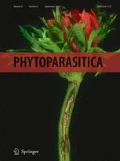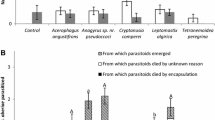Abstract
In September 1993, a colony ofHarmonia axyridis Pallas (Coleoptera:Coccinellidae) was imported from France into Greece. In 1994, insectary-reared adults were released in 11 citrus orchards in four citrus-growing areas of Greece. Between May 19 and June 8, 1994,H. axyridis was recovered from a total of seven localities in three of these areas. This species was established on orange, mandarin and sour orange trees heavily infested withToxoptera aurantii, Aphis spiraecola andA. gossypii; its absence from the remaining four localities may have been the result of low prey densities. Twenty-three days after the initial releases,H. axyridis larvae comprised 57.9% and 83.3%, respectively, of the aphidophagous coccinellid larval populations in two localities (on Chios Island). In samples taken at Leonidion 43 days after the introduction release, both adult and larval populations ofH. axyridis represented approximately one-third of aphidophagous coccinellid adults and larvae found, whereas the indigenousAdalia bipunctata comprised about one-half of the population. In cages placed outside the Athens laboratory,H. axyridis completed four overlapping generations annually; average longevities of 56.2, 66.8, 78.9 and 102.2 days, respectively, were recorded for the successive generations. Adults of the 3rd and 4th generations overwintered, giving rise to the following year’s 1st generation. Oviposition began in April and emergence of 1st generation adults occurred in mid-May. The egg-laying activity of the females throughout the warm period of the year indicates thatH. axyridis does not diapause in summer. From December until March, small aggregations (2-4 individuals) were observed within the cages at protected sites.
Similar content being viewed by others
References
Aksyutova, L.N. and Gul’dyaeva, T.I. (1977) [Insect enemies of orchard pests in the Amur region.]Zashch. Rast. 5: 26 [in Russian].
Dong, Y.G. (1988) [Trials on the controlof Aphis gossypii Glover withCoccinella axyridis Pallas.]Zhejiang Agric. Sci. 3: 135–139 [in Chinese].
Fan, Y.H. and Yang, S.Y. (1983) Occurrence ofLeis axyridis (Pallas) (Col.: Coccinellidae).Nat. Enemies Insects Kunchong Tiandi 5: 94–96. [Rev. Appl. Entomol. (1984) 72: 319]
Gao, J.F. (1990) [Survey for the natural enemies of soybean aphids in Tonghua.]Chin. J. Biol. Control 6: 90 [in Chinese].
Garcia, V. (1986) Approaches to integrated control of some citrus pests in the Azores and Algarve (Portugal).in: Cavalloro, R. and Martino, E.D. [Eds.] Integrated Pest Control in Citrus Groves.Proc. CEC Experts’ Meeting (Acireale, Italy), pp. 557–559.
Katsoyannos, P. (1993) IPM for citrus insect pests in northern Mediterranean countries.FAO Plant Prot. Bull. 41: 177–197.
Katsoyannos, P. and Stathas, G.J. (1991) [Dysaphis crataegi (Homoptera, Aphidoidea, Aphididae) as a suitable prey for coccinellid predators in insectary rearings.]Proc. 4th Panhellenic Congress of Entomology Volos, Greece), [in Greek].
Koval, Yu.V., Zderchuk, I.S. and Voronin, K.E. (1973) [Physiological and biochemical factors, favouring acclimatisation of the Far Eastern harmonia coccinellidLeis axyridis Pall. in Soviet Bukovina.]Tr. Vses. Nauchno-issled. Inst. Zashch. Rast. 36: 33–42 [in Russian].
McClure, M.S. (1987) Potential of the Asian predator,Harmonia axyridis Pallas (Coleoptera: Coccinellidae), to controlMatsucoccus resinosae Bean and Godwin (Homoptera: Margarodidae) in the United States.Environ. Entomol. 16: 224–230.
Obata, S. and Johki, Y. (1990) Distribution and behaviour of adult ladybirdHarmonia axyridis Pallas (Coleoptera, Coccinellidae), around aphid colonies.Jpn. J. Entomol. 58: 839–845.
Sakurai, H., Kawai, T. and Takeda, S. (1988) [Physiological characteristics of diapause in the lady beetleHarmonia axyridis Pallas.]Res. Bull. Fac. Agric. Gifu Univ. 53: 127–131 [in Japanese].
Savoiskaya, G.I. (1970) [The Far-Eastern ladybird against the apple aphid.]Zashch. Rast. 15: 12–13 [in Russian].
Schanderl, H., Ferran, A. and Larroque, M.M. (1985) Les besoins trophiques et thermiques des larves de la coccinelleHarmonia axyridis Pallas.Agronomie 5: 417–421.
Takahashi, K. (1989) Intra and inter-specific predation of ladybeetles in spring alfalfa fields.Jpn. J. Entomol. 57: 199–203.
Wu, Q.L. (1986) [Investigation on the fluctuations of dominant natural enemy populations in different cotton habitats and integrated application with biological agents to control cotton pests.]Nat. Enemies Insects 8: 29–34 [in Chinese]. [Rev. Appl. Entomol. (1988) 76: 142]
Author information
Authors and Affiliations
Rights and permissions
About this article
Cite this article
Katsoyannos, P., Kontodimas, D.C., Stathas, G.J. et al. Establishment ofHarmonia axyridis on Citrus and Some Data on Its Phenology in Greece. Phytoparasitica 25, 183–191 (1997). https://doi.org/10.1007/BF02981731
Received:
Revised:
Issue Date:
DOI: https://doi.org/10.1007/BF02981731




